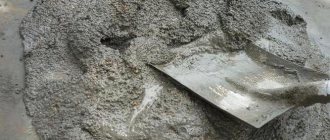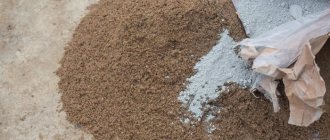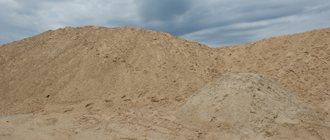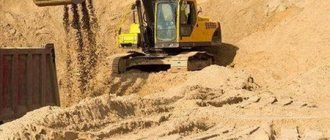Calculating the volume of sand is an important construction task, because this material is used in many types of work:
- construction of fences and foundations;
- pouring the blind area;
- screed formation, etc.
Bulk materials are often purchased in tons, or even by the carload, so it is important to be able to convert mass into volumes in order to be able to calculate the exact amount of raw materials.
How to calculate the weight of sand per 1 cubic meter - features
Inexperienced and novice builders, such as people living in country houses, are very often puzzled by how many kilograms are contained in one cube. Sand is used for the construction of the main residential building, as well as for the improvement of the surrounding area, and the construction of additional buildings that improve the use and comfort of staying outside the city. The second and no less important question is the price and delivery of sand, how many cubes are in the sand that the seller will bring.
The correct calculation regarding the number of kilograms of sand in 1 cube will have an impact on the completed structure; an incorrect calculation can lead to the destruction of the structure. When mixing the concrete mixture, cement is combined with sand - the correct calculation of the ratios affects the quality and service life of the structure.
Classification
Most often, the classification of construction sand occurs according to such an indicator as the presence of minerals in it. According to this factor, two types of mixtures are distinguished:
- monomineral materials. Such sand contains fractions of only one type of mineral. Only quartz, mica, feldspar or hornblende can be distinguished;
- polymineral materials. This sand is different in that its composition contains several different minerals. It can be quartz with mica, quartz with feldspar, or mica with quartz. In the first place in the name is the substance that predominates as a percentage of the entire volume.
The type of mineral also indirectly affects how much 1 cube of sand weighs. This is due to the fact that they can have different fractions, different densities and certain characteristic features.
Correct calculation of the amount of sand in one cube
Fine-grained sand, density 1700 - 1800 kg/m3, and humidity should be within 6 - 7%.
1 m³ of such material will weigh about 1.7 - 1.8 tons.
The dump truck body volume is usually 12 m³:
1700 kg * 12 m³ = 20400 kg, that is, 20.4 tons.
If the humidity of the sand reaches 20%, then its mass will increase by 4 tons, therefore, one dump truck can accommodate about 25 tons of such material.
Next, you can look at the table, which provides information on the mass of 1 m³ of this or that type of sand.
| Type of material | Number of tons in 1 m3 |
| Dry | 1,21 — 1,75 |
| river sand | 1,5 |
| compacted | 1,59 |
| coarse-grained | 1,47 — 1,63 |
| Building | 1,68 |
| Construction dry friable | 1,44 |
| Construction dry compacted | 1,68 |
| Quarry sand | 1,5 |
| fine-grained | 1,72 — 1,8 |
| Quartz sand | 1,41 — 1,95 |
| Nautical | 1,62 |
| gravelly | 1,7 — 1,9 |
| Dusty | 1,61 — 1,75 |
| Natural coarse | 1,49 — 1,61 |
| Natural medium grain | 1,53 — 1,64 |
| Normal humidity for construction work | 1,54 — 1,7 |
| Mountain | 1,5 — 1,6 |
| Chamotte | 1,4 |
| Perlite | 0,074 — 0,4 |
| Ovrazhny | 1,4 |
| Alluvial | 1,65 |
| Medium size | 1,5 — 1,7 |
| Large | 1,53 — 1,6 |
| Small | 1,7 — 1,8 |
| Washed sand | 1,3 — 1,6 |
| Compacted | 1,68 |
| Wet | 1,92 |
| Wet | 2,08 |
| Water-saturated | 3 — 3,2 |
| Pumice | 0,5 — 0,6 |
| sand soil | 2,66 |
| Sand and crushed stone | 1,5 — 1,8 |
| Sand and cement | 1,1 — 1,7 |
| Clay red brick fight | 1,2 |
| Magnesite | 2 |
| Titanium alumina | 1,7 |
| Basaltic | 1,8 |
*Weight is not completely accurate as it constantly changes depending on density and humidity.
Table
| View | Specific gravity, kg/cu.m. m |
| Construction sand | 1500 |
| Sand builds. dry fluffy | 1440 |
| Sand builds. dry compacted | 1680 |
| Sand builds. wet | 1920 |
| Sand builds. wet compacted | 2545 |
| Molding sand | 1710 |
| River sand | 1630 |
| Washed river sand | 1500 |
| Compacted river sand | 1590 |
| Quartz sand | 1650 |
| Dry quartz sand | 1500 |
| Compacted quartz sand | 1650 |
| Quarry sand | 1500 |
| Gully sand | 1400 |
| Mountain sand | 1540 |
Size of sand grains, their effect on total weight
The weight of sand in one cube depends on the size of the grains of sand. Taking into account the size of the grains of sand, it is possible to determine the weight of the sand contained in one cube, which is closest to the real figures. For this, a sieve is used, in which the size of the cells allows grains of sand to pass through the sieve without obstacles, but at the same time they are also filtered from debris in the form of stones and sticks.
| Size | Diameter in mm |
| Small | 1.5-2 mm |
| Average | 2-2.5 mm |
| Large | More than 2.5 mm |
Based on the size of sand grains, they are divided into two classes:
- I – the size of sand grains in diameter does not exceed 1.5 mm.
- II – the size of sand grains is not limited by size.
To the question - how many cubes of sand are in 1 ton? we answer like this: 0.65 cubic meters.
Physical differences
The composition of sand includes a great variety of different minerals, rock particles, and possibly the ingress of skeletons of organisms.
Its composition can vary even within the same deposit; this is due to additional impurities, which are very diverse.
It is classified according to the following indicators.
By grain size:
- sand dust;
- fine fraction;
- large faction;
- gravel;
- crushed stone
By location and conditions of formation:
- dune;
- dune;
- river;
- nautical;
- mountain.
By composition:
- lime;
- magnetic;
- quartz;
- gold-bearing.
Sand consists of fragments of the following minerals:
- feldspars;
- quartz;
- mica;
- various impurities, such as small fragments of rocks and skeletons;
By grain size:
- coarse-grained;
- clayey;
- medium grain;
- fine-grained;
- dusty.
Sand can vary in density, the pattern is as follows: the finer the grains, the stronger their compaction occurs. This may also be influenced by other factors acting from the external environment. Setting the weight of sand to 1 m³ is not so simple; it must be calculated taking into account many rules, such as its composition, grain size, density, humidity and others.
Calculation of the mass of sand used in construction per cubic meter
A simple formula will help you calculate the mass of sand contained in one cube:
m=V*p
m – weight of sand;
V – volume;
P – degree of compaction.
Using this formula, you can determine the mass; data on the volume, type of sand, and compaction can be obtained from the supplier.
Before purchasing, check with the supplier how wet the sand is, since humidity increases the weight by 6-7%. After purchasing wet sand, its drying weight may decrease by 20% of its original value.
Price
The main advantage of quarry sand remains its low price. If you purchase the material in question in a volume of 1 m3, its price will be 500 rubles. The presented product can be sold in its pure form or already processed. Of course, when purchasing the second option, you will need to spend a little more, because such a product is characterized by high quality indicators.
Quarry sand is considered the most popular material in the field of construction. The reason for such demand is that it is not expensive and can be used everywhere. But it cannot be used in its pure form in all cases, since it contains foreign impurities that negatively affect the quality characteristics.
Often suppliers deceive their customers and do not add enough sand, because I know that the client will never know exactly how many tons of sand they brought him. But if you know at least approximately the specific gravity of sand and know the cubic capacity of the machine in which the sand was brought to you, then it will not be difficult for you to at least roughly calculate how much sand was brought to you, since you will see how full the machine is.
If you’re not at all lazy, you can use a tape measure and measure how much sand they brought you.
Analysis of sand density level in the laboratory and independently
Based on the data on the compaction coefficient of ASG, pitch or soil, it is necessary to determine whether the actual density of the base corresponds to the desired value.
Using samples
The most accurate, but not the fastest method of analysis. To carry it out, you need to contact a laboratory, since such actions cannot be carried out directly on the construction site. The sample is taken using cylinders, immersing them in the sand without disturbing the structure of the sand, several samples are taken and each of them is analyzed.
Samples are taken from different places in the soil and placed in a container in which the soil structure will be preserved as much as possible. After which the samples are weighed, an analysis is carried out for soil compaction, depending on the area in which it was carried out. Based on the identified indicators, a further decision is made about whether it is worth further compacting the soil.
Dynamic Density Meter
A tool that allows you to check the level of soil density on site. It consists of a rod, a handle and a striking pad, and an additional load. It will help you quickly check the condition of the soil.
The density meter is installed in the required area using a platform. After which the load must be lifted and sharply dropped onto the main platform, after such manipulations the iron rod gradually enters the soil, but it is important to control the number of blows made.
The metal tip must be completely immersed in the soil, after which the data obtained is compared with a table of soil compaction readings; if the data does not correspond to the norm, then the soil is further compacted; if the KU indicators are normal, construction work can continue.
The soil is compacted using vibrating plates and tamping equipment, both mechanical and manual. The CG indicator should be close to one. At such indicators, the degree of soil compaction will become maximum, the presence of air pockets in the soil will be reduced to nothing.
Using electromagnets
Measurements are carried out using a device that emits electromagnetic waves that penetrate the soil and are recorded on a sensor. Based on the data obtained, soil compaction is analyzed. The data obtained is compared with data from laboratories.
They check the soil at five different points, their location resembling the shape of a maple leaf. This method takes the longest and the results may be inaccurate. Errors in the results may occur if there are large stones in the soil, or the soil is very wet and consists of different rocks.
Degrees of compaction and moisture content
The weight of a cube of construction sand also depends on the degree of compaction of this material . Experts, focusing on this indicator, divide the mixture into the following types:
- state of natural occurrence of sand;
- artificially compacted or compacted material;
- bulk sand mixture.
The more compacted the material, the greater the weight of the cube of sand . Since builders use bulk mixtures in most cases, purchases should also be made in this form.
Plastering walls is the most common and important point during construction work. By clicking on the link, you will find out the consumption of rotband plaster per 1 m2.
Tile frost-resistant adhesive has found wide application not only for external, but also for internal work. Here's everything about frost-resistant tile adhesive.
Cement is a bulk substance that is very widely used in various types of construction. Here you can find out what cement is made of.
It is worth paying attention to such a physical quantity as humidity. It affects the volume of material, but not very significantly. Most often, decisions should be made taking this into account during the winter season.
Humidity
This is primarily due to the fact that in cold weather and in the presence of snow, the amount of water in the sand mass can be about 15 percent of its total weight.
Liquid can increase both the specific gravity of sand (most often) and bulk density (to a lesser insignificant extent). Because of this, it is best not to purchase sand in winter, which is stored in conditions of high humidity due to the presence of ice and snow particles in it.











